
Embracing the Rooftop Revolution: My Journey with Green Roofs
As an experienced roofing contractor, I’ve had the privilege of working on a wide range of projects over the years. But one area that has truly captured my imagination and passion is the world of green roofs. These living, breathing canopies atop our buildings are not just aesthetically pleasing – they represent a powerful tool in our quest for sustainability and urban resilience.
The Transformative Power of Green Roofs
When I first encountered green roofs, I was struck by the sheer scope of their impact. These verdant havens don’t just beautify our cityscapes; they play a crucial role in mitigating the heat island effect, reducing energy consumption, and enhancing stormwater management. As a roofing specialist, I’ve seen firsthand how green roofs can transform the way we interact with our built environment.
Think about it – a traditional roof, with its dark, impermeable surfaces, can absorb and radiate heat, contributing to the dreaded urban heat island effect. But a green roof, with its lush vegetation and soil, acts as a natural insulator, keeping buildings cooler and reducing the demand for air conditioning. In fact, studies have shown that green roofs can lower surface temperatures by a staggering 30-40°F compared to conventional roofs. And the benefits don’t stop there – these verdant oases can also reduce a building’s energy consumption by up to 0.7%, leading to significant cost savings over time.
But the advantages of green roofs extend far beyond just energy efficiency. They also play a vital role in stormwater management, a crucial concern in many urban areas. By absorbing and filtering rainwater, green roofs can reduce the burden on local drainage systems, helping to mitigate the risk of flooding and pollution. And as an added bonus, the water that is retained can be reused for irrigation, further enhancing the sustainability of the system.
Cultivating Urban Resilience
As cities continue to grapple with the challenges of urbanization and climate change, green roofs have emerged as a powerful tool in building urban resilience. By integrating nature into our built environment, we can create a more harmonious and adaptive ecosystem that is better equipped to withstand the stresses of modern life.
I’ve seen firsthand how green roofs can transform urban landscapes, providing much-needed green spaces and habitat for local wildlife. In a world where concrete and steel often dominate, these rooftop gardens offer a respite, a place for people to connect with nature and recharge their mental and physical well-being. And as we’ve seen, the environmental benefits of green roofs extend far beyond the individual building, positively impacting the surrounding community.
Overcoming Challenges and Embracing Innovation
Of course, the journey of bringing green roofs to life is not without its challenges. Navigating the complexities of design, installation, and maintenance can be a daunting task, requiring close collaboration between roofing professionals, architects, and landscape designers. But as an industry, we’ve risen to the occasion, constantly evolving and innovating to overcome these hurdles.
One area where I’ve seen significant progress is in the development of new roofing materials and techniques specifically tailored for green roof applications. Gone are the days of relying on traditional roofing membranes, which can be susceptible to damage from the weight and moisture of a living roof. Today, we have access to specialized, lightweight substrates and drainage systems that make the installation of green roofs more efficient and effective.
And the innovation doesn’t stop there. I’ve been excited to see the emergence of advanced technologies like hydroponic and aquaponic systems, which allow for the cultivation of food crops on rooftops. By integrating these cutting-edge agricultural practices with green roof design, we can create truly sustainable and self-sufficient urban oases, providing fresh produce while also reaping the environmental benefits.
Embracing the Future of Roofing
As I reflect on my journey in the roofing industry, I can’t help but feel a deep sense of excitement about the future of green roofs. These dynamic systems represent a profound shift in the way we approach the built environment, moving away from the traditional and toward a more harmonious integration of nature and technology.
When I talk to homeowners or builders, I often ask them to imagine a world where our rooftops weren’t just functional, but actively contributing to the health and resilience of our communities. A world where the very act of building a new structure or re-roofing an existing one was an opportunity to create a thriving, sustainable ecosystem. It’s a vision that I’m passionate about, and one that I believe will only continue to grow in importance as we grapple with the pressing challenges of our time.
Conclusion: A Call to Action
So, if you’re a homeowner or a builder, I encourage you to explore the transformative potential of green roofs. Reach out to experienced roofing contractors like myself who can guide you through the process, from assessing the feasibility of a green roof to designing and installing a system that meets your unique needs.
Together, let’s cultivate a future where our cities are not just concrete jungles, but thriving, resilient landscapes that seamlessly integrate the natural world with our built environment. It’s a future that’s within our grasp, and one that I’m honored to be a part of as a roofing professional. So, let’s get to work and unlock the power of green roofs to shape a more sustainable, livable world.

